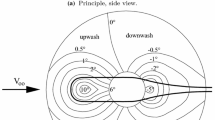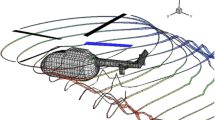Abstract
The flow field around the isolated Bo105 fuselage including the tail boom and empennage is computed by an unsteady panel code. Velocities normal to the rotor rotational plane are extracted in a volume around the rotor as a data base. A simple semi-empirical analytical formulation of the fuselage-induced velocities, based on parameter estimation from the panel code data, is extended to include rotor shaft angles of attack from \(\alpha =-90^{\circ }\) (hover, vertical climb) to +90° (vertical descent) for use in comprehensive rotor codes. This model allows the computation of fuselage–rotor interferences on the rotor blade element level in a simplified form, thus eliminating the need for costly CFD computation (of this effect). It also allows the prediction of the rotor wake geometry deformation due to the presence of the fuselage in both prescribed wake and free-wake codes. Its impact on rotor thrust, power and trim is estimated analytically using blade element momentum theory.















Similar content being viewed by others
Abbreviations
- A, B :
-
Non-dimensional radial effective begin and end of airfoiled section
- \(A_0\) :
-
Non-dimensional magnitude of fuselage-induced flow
- c :
-
Rotor blade chord (m)
- \(C_{l\alpha }\) :
-
Lift curve slope (1/rad)
- \(c_{kn}\) :
-
Polynomial coefficient
- \(C_T\) :
-
Thrust coefficient, \(C_T=T/[\rho \pi R^2(\Omega R)^2]\)
- \(C_W\) :
-
Weight coefficient, \(C_W=W/[\rho \pi R^2(\Omega R)^2]\)
- \(\mathrm{d}(n)\) :
-
Radial integral coefficient, \(\mathrm{d}(n)=\int _A^Br^{n-1}\mathrm{d}r=(B^n-A^n)/n\)
- M :
-
Mach number
- \(M_\beta\) :
-
Aerodynamic moment about flap hinge (Nm)
- \(N_b\) :
-
Number of blades
- r :
-
Non-dimensional radial coordinate
- R :
-
Rotor radius (m)
- \(S_A, S_x, S_y\) :
-
Shape functions of amplitude, in x- and in y-direction
- T :
-
Rotor thrust (N)
- \(v_{izf}\) :
-
Fuselage-induced velocity normal to the hub plane, pos. downwards (m/s)
- \(v_{i0}\) :
-
Thrust-induced velocity, pos. downwards (m/s)
- \(V_T\) :
-
Tangential velocity at the blade element in the hub plane (m/s)
- \(V_P\) :
-
Velocity at the blade element perpendicular to the hub plane (m/s)
- \(V_\infty\) :
-
Airspeed (m/s)
- W :
-
Helicopter weight (N)
- x, y, z :
-
Hub-fixed coordinates (m)
- \(x_0, y_0, z_0\) :
-
Position of maximum induced velocities (m)
- \(\alpha , \alpha _a\) :
-
Shaft and blade element angle of attack (°)
- \(\beta\) :
-
Side-slip angle (°)
- \(\Theta\) :
-
Blade element pitch angle (°)
- \(\Theta _C, \Theta _S\) :
-
Lateral and longitudinal cyclic control angle (°)
- \(\lambda _{if}\) :
-
Fuselage-induced inflow ratio, \(\lambda _{if}=v_{izf}/V_\infty\)
- \(\lambda _{i0}\) :
-
Thrust-induced inflow ratio, \(\lambda _{i0}=v_{i0}/(\Omega R)\)
- \(\mu\) :
-
Advance ratio, \(\mu =V_\infty \cos \alpha /(\Omega R)\)
- \(\mu _z\) :
-
Axial advance ratio, \(\mu _z=-V_\infty \sin \alpha /(\Omega R)=-\mu \tan \alpha\)
- \(\rho\) :
-
Air density (kg/m\(^3\))
- \(\sigma\) :
-
Rotor solidity (rectangular blade), \(\sigma =N_bc/(\pi R)\)
- \(\psi\) :
-
Rotor blade azimuth (°)
- \(\Omega\) :
-
Rotor rotational frequency (rad/s)
References
Sheridan, P.F., Smith, R.P.: Interactional aerodynamics: a new challenge to helicopter technology. J. Am. Helicopter Soc. 25(1), 3–21 (1980)
Huber, H., Polz, G.: Studies on blade-to-blade and rotor–fuselage–tail interferences. Aircr. Eng. Aerosp. Technol. 55(10), 2–12 (1983)
Keys, C., Wiesner, R.: Guidelines for reducing helicopter parasite drag. J. Am. Helicopter Soc. 20(1), 31–40 (1975)
Stepniewski, W.Z., Keys, C.N.: Rotary-wing aerodynamics. ISBN 0-486-64647-5, Dover Publications (1984)
Leishman, J.G.: Principles of helicopter aerodynamics. ISBN 0-521-66060-2, Cambridge University Press (2001)
Dreier, M.E.: Introduction to helicopter and tiltrotor flight simulation. ISBN-13: 978-1-56347-873-4, AIAA Education Series, Reston, VA (2007)
van der Wall, B.G., Bauknecht, A., Jung, S.N., You, Y.H.: Semi-empirical modeling of fuselage-rotor interference for comprehensive codes: the fundamental model. CEAS Aeronaut. J. 5(4), 387–401 (2014)
van der Wall, B.G.: A comprehensive rotary-wing database for code validation: the HART II International Workshop. Aeronaut. J. R. Aeronaut. Soc. 115(1163), 91–102; erratum: 115(1166), 220 (2011)
Clark, D.R., Maskew, B.: Calculation of unsteady rotor blade loads and blade/fuselage interference. In: 2nd International conference on rotorcraft basic research, College Park, MD, 16–18 Feb 1988
Clark, D.R., Maskew, B.: A re-examination of the aerodynamics of hovering rotors including the presence of the fuselage. In: International technical specialists’ meeting on rotorcraft basic research, Atlanta, Georgia, 25–27 March 1991; also in: 47th Annual Forum of the American Helicopter Society, Phoenix, AZ, 6–8 May 1991
Wachspress, D.A., Quackenbush, T.R., Boschitsch, A.H.: Rotorcraft interactional aerodynamics with fast vortex/fast panel methods. J. Am. Helicopter Soc. 48(4), 223–235 (2003)
Brown, R.E., Line, A.J., Ahlin, G.A.: Fuselage and tail-rotor interference effects on helicopter wake development in descending flight. In: 60th American Helicopter Society Annual Forum, Baltimore, MD, 7–10 June 2004
Brown, R.E., Line, A.J.: Efficient high-resolution wake modeling using the vorticity transport equation. AIAA J. 43(7), 1434–1443 (2005)
Kim, H.W., Kenyon, A.K., Duraisamy, K., Brown, R.E.: Interactional aerodynamics and acoustics of a propeller-augmented compound coaxial helicopter. In: American Helicopter Society Specialists’ Conference on Aeromechanics, San Francisco, CA, 23–25 Jan 2008
D’Andrea, A.: Development of a multi-processor unstructured panel code coupled with a CVC free wake model for advanced analyses of rotorcrafts and tiltrotors. In: 64th Annual Forum of the American Helicopter Society, Montreal, Canada, 29 April–1 May 2008
Keller, J.D., Wachspress, D.A., Hoffler, J.C., Kachman, N.J., Nichols, J.: Application of a real time free wake induced velocity model in a Naval rotorcraft flight trainer. In: 67th Annual Forum of the American Helicopter Society, Virginia Beach, VA, 3–5 May 2011
Quon, E.W., Smith, M.J., Whitehouse, G.R., Wachspress, D.A.: Unsteady reynolds-averaged Navier–Stokes-based hybrid methodologies for rotor–fuselage interaction. J. Aircr. 49(3), 961–965 (2012)
Yin, J.: Main rotor and tail rotor blade–vortex interaction noise under the influence of the fuselage. In: 38th European Rotorcraft Forum. Amsterdam, The Netherlands 4–7 Sept 2012
Yin, J., van der Wall, B.G., Oerlemans, S.: Representative test results from HELINOVI aeroacoustic main rotor/tail rotor/fuselage test in DNW. In: 31st European Rotorcraft Forum. Florence, Italy 13–15 Sept 2005
Jacob, H.G.: Rechnergestntzte optimierung statischer und dynamischer Systeme. Fachberichte Messen, Steuern, Regeln, Band 6; ISBN 3-540-11641-9, Springer Verlag (1982)
Author information
Authors and Affiliations
Corresponding author
Rights and permissions
About this article
Cite this article
van der Wall, B.G., Yin, J. Semi-empirical modeling of fuselage–rotor interference for comprehensive codes: influence of angle of attack. CEAS Aeronaut J 6, 557–574 (2015). https://doi.org/10.1007/s13272-015-0163-2
Received:
Revised:
Accepted:
Published:
Issue Date:
DOI: https://doi.org/10.1007/s13272-015-0163-2




